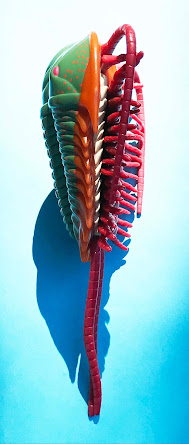Trilobites belong to Phylum Arthropoda, whose members are characterized by a segmented body that has fusion and specialization of groups of segments into two or three major body regions (head, abdomen, and tail). The body consists of a rigid chitinous + calcium carbonate or calcium-phosphate exoskeleton that must be shed periodically in order for the animal to grow larger. This process thereby allows for the possibility of many fossils being created by a single animal.
Shown above is Olenellus fremonti, a trilobite of Early Cambrian age approximately 525 million years old. The head (cephalon) of this specimen is very obvious, as is the abdomen. The tail, however, is hard to distinguish from the abdomen. The specimen shown here is 7.8 cm in length, but its left side is partially missing. The rock is a slightly metamorphosed brittle siltstone, that approaches being slate. The eyes of this specimen are not very well preserved, but the left eye shows the best preservation. Regarding trilobite eyes, you might want to check out one of my early posts on this subject matter.
The above plastic replica (three views: top, bottom, and right side) of Olenellus is the best replica of a trilobite that I have ever seen. It shows the exoskeleton (the outer surface = green color “created” by the manufacturer of the replica), which is underlain by the gills (white color), which is underlain by the numerous thin legs (red color). This replica also shows the two antennae, front and aft, which are found on some olenellids. Their preservation, however, is very rare.
Bristolia bristolensis (36 mm length) is also of Early Cambrian age and from the same rocks that contain Olenellus fremonti. This is mostly a complete specimen of B. bristolensis. The abdominal spines present on Bristolia were undoubtedly used for protection against predators. The exoskeletons of trilobites were flexible, thus this lateral spines could be flexed upward, like prongs.
By comparing B. bristolensis with O. fremonti, you can see that the cephalon (head) of Bristolia is more rectangular.





No comments:
Post a Comment